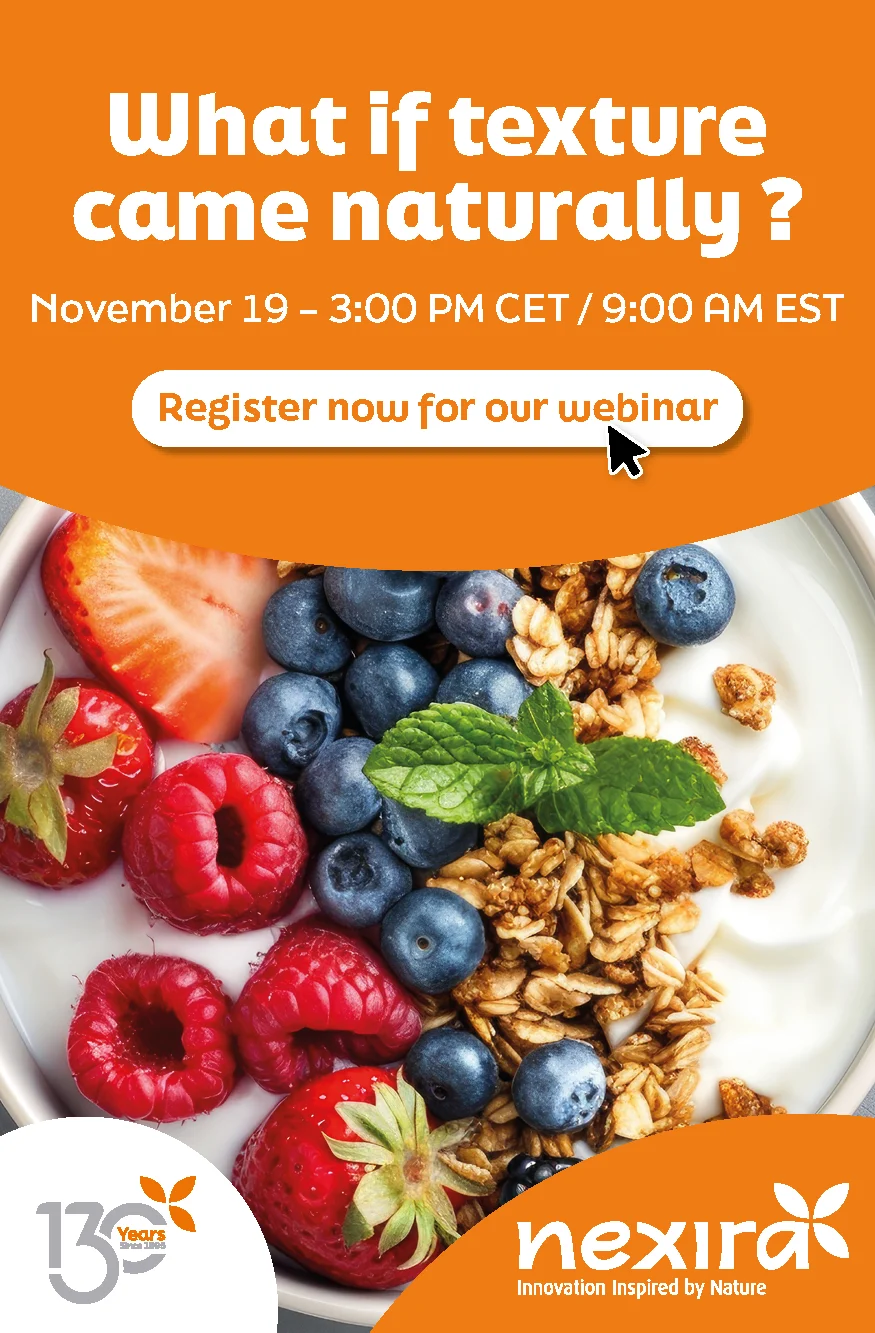Nexira webinar preview: Exploring natural texture potential in indulgent foods
Key takeaways
- Nexira’s acacia fiber and Naltive locust bean gum (LBG) deliver premium creaminess in dairy and plant-based ice creams.
- The company offers “tasty and healthy” ingredient solutions for desserts that balance indulgent texture with nutritional benefits.
- Through Nexira’s Acacia Program and its long-term partnership with SOS Sahel, the company ensures responsible sourcing and ecosystem preservation.
Consumers are increasingly demanding indulgent textures with cleaner labels and more natural ingredients. According to Nexira, this demand is especially prevalent in dairy and plant-based alternative applications. In response, the company highlights a growing demand for ice cream that delivers both indulgence and a healthier profile.
One new concept showcasing the unique functionality of Nexira’s ingredients is an ice cream where its acacia gum naturally replaces the synthetic emulsifier E471 (mono- and diglycerides of fatty acids). Case studies like these showcase how natural solutions deliver stability, creaminess, and mouthfeel without compromising on clean label requirements.
Food Ingredients First speaks with Charlotte Wallart, food product manager at Nexira, ahead of the company’s webinar titled, “What if texture came naturally?”
Follow this link to register for the free webinar, which will broadcast on Wednesday, November 19, at 3 PM CET.
How has clean label demand shaped Nexira’s approach to natural texture?
Wallart: Clean label is embedded in our DNA. As demand for naturality and reduced ultra-processing accelerates, our approach remains consistent: 100% plant-based ingredients, obtained through gentle processes that preserve native functionality. This commitment is holistic, supported by responsible sourcing programs such as our Acacia Program and our long-standing partnership with SOS Sahel.
In dairy and plant-based ice cream applications, texture is a non-negotiable performance criterion. Consumers expect clean label products and premium creaminess. Our acacia fiber and Naltive LBG provide natural structuring, stabilization, and mouthfeel enhancement, enabling formulators to achieve optimal texture and indulgence without synthetic additives.
What unique properties make acacia gum and LBG ideal for creaminess and mouthfeel, and how do they compare with E471?
Wallart: Acacia gum and LBG each play a distinct but highly complementary role in delivering creaminess and mouthfeel. Acacia gum provides natural emulsification without adding viscosity. Thanks to its intrinsic properties, it can fully replace E471 in ice cream formulations while maintaining mix stability, smooth texture, and controlled meltdown — delivering the same functional outcomes without synthetic emulsifiers. This enables a cleaner, natural ingredient list.
LBG is an ideal partner for acacia gum. It hydrates at low temperatures, builds viscosity, forms a protective network that limits ice crystal growth, and enhances roundness and creaminess. Together, they create a robust, 100% plant-based system that achieves the desired indulgent texture and sensory quality while supporting clean label objectives.
What are the latest US and EU market drivers behind “indulgent yet healthier” frozen desserts and plant-based alternatives?
Wallart: Across the US and EU, the shift toward indulgent yet healthier frozen desserts is driven by a broader movement toward functional F&B — now a structural trend. Consumers increasingly want products that not only taste good but also “do them good,” combining pleasure with naturality and nutritional benefits.
Ice cream and plant-based alternatives are fully part of this momentum. Functional and better-for-you ice creams are gaining shelf presence, reflecting rising interest in products that deliver added value without compromising indulgence. Texture remains decisive: “creaminess” is one of the strongest cues for indulgence, and nearly two in five consumers rank taste as the top factor in at-home choices. Around 30% believe that using more natural ingredients and fewer artificial ones is the best way to make indulgent categories healthier — strengthening the clean label expectation.
In the case of ice cream, specifically, about two-thirds of consumers cite taste and flavor as key purchase drivers, and more than one in five look for products made in a more traditional or artisanal manner. In the plant-based space, over 20% of consumers report that texture remains a gap — highlighting clear opportunities to deliver a more premium, creamy mouthfeel in dairy alternatives.
In your webinar case study, acacia gum replaces synthetic emulsifiers. How does it perform from stability, texture, and sensory perspectives?
Wallart: In our case study, acacia gum demonstrated that it can effectively replace synthetic emulsifiers such as E471 while maintaining key processing and sensory performance. In a like-for-like ice-cream formulation at 0.4% acacia gum, we observed:
- Process stability: Acacia gum delivered the same mix viscosity before freezing and showed comparable resistance to temperature variations during aging, confirming robust emulsion stability.
- Physical behavior: Melting kinetics were equivalent to the E471 control, indicating proper structure and phase retention during consumption.
- Sensory performance: The overall sensory profile — including creaminess, smoothness, and flavor release — matched the mono-/diglyceride reference.
 Nexira’s acacia gum can naturally replace the synthetic emulsifier E471 in ice cream applications.This demonstrates that acacia gum provides reliable natural emulsification, ensuring stability and indulgence while enabling a cleaner label and a “natural emulsifier” claim by removing synthetic additives
Nexira’s acacia gum can naturally replace the synthetic emulsifier E471 in ice cream applications.This demonstrates that acacia gum provides reliable natural emulsification, ensuring stability and indulgence while enabling a cleaner label and a “natural emulsifier” claim by removing synthetic additives
How do you balance indulgent texture with healthier formulations in today’s dairy and plant-based market?
Wallart: We balance indulgence and health by using a combined texture and nutrition approach. LBG delivers the sensory cues consumers expect — creaminess, roundness, and controlled meltdown — while ensuring a premium mouthfeel in both dairy and plant-based desserts. In parallel, acacia fiber allows us to elevate the nutritional profile without compromising texture. It offers high digestive tolerance, a clinically proven prebiotic effect at 10 g per day, and no impact on taste or viscosity, making it ideal for “tasty and healthy” concepts. Together, they provide a fully natural, 100% plant-based system that supports indulgent textures and better-for-you positioning.
How do acacia gum and LBG advance more sustainable, natural formulations?
Wallart: Acacia gum and LBG both contribute to more sustainable, naturally sourced formulations. Acacia is obtained through gentle, controlled processing from tree to ingredient, with organic and even carbon-neutral references available. Nexira has been committed to the sustainability of acacia ecosystems since the 1970s through our partnership with the NGO SOS Sahel. Our Acacia Program further strengthens this commitment by improving resource management, supporting local communities, and ensuring a more durable and resilient supply chain. Acacia’s natural emulsifying properties also help remove controversial synthetic additives while maintaining performance.
Furthermore, LBG is equally aligned with sustainability expectations. It is 100% plant-based and mechanically processed from Mediterranean carob seeds, with organic grades available. Its straightforward labeling (“locust bean gum” or “carob bean gum”) supports clean label declarations and reinforces its natural origin. Together, acacia and LBG offer robust functionality, enabling manufacturers to build truly natural and responsible formulations.



















